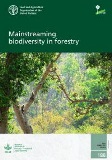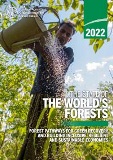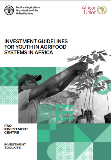Accelerate > Publications
Search this online library featuring the latest FAO publications, issue papers and briefs which offer up-to-date knowledge and innovative insights for SDG acceleration.

The State of Food Security and Nutrition in the World 2022 - Repurposing food and agricultural policies to make healthy diets more affordable
2022
This year’s report should dispel any lingering doubts that the world is moving backwards in its efforts to end hunger, food insecurity and malnutrition in all its forms. We are now only eight years away from 2030, but the distance to reach many of the SDG 2 targets is growing wider each year. There are indeed efforts to make progress towards SDG 2, yet they are proving insufficient in the face of a more challenging and uncertain context.

Mainstreaming biodiversity in forestry
2022
This study is a collaboration between FAO and the Center for International Forestry Research (CIFOR), lead centre of the CGIAR research programme on Forests, Trees and Agroforestry (FTA). Illustrated by eight country case-studies, the report reviews progress and outlines the technical and policy tools available for countries and stakeholders, as well as the steps needed, to effectively mainstream biodiversity in forestry.

Making way - developing national legal and policy frameworks for pastoral mobility
2022
This handbook calls for the legal recognition and securing of pastoral mobility as a way of safeguarding and facilitating a continuous stream of economic and social benefits for pastoralists, countries, and the environment. It facilitates a deeper understanding of pastoral mobility through examples and case studies drawn from various parts of the world and identifies considerations to be borne in mind when legislating for mobility.

FAO’s work on South–South and Triangular Cooperation in sub-Saharan Africa: Exchanging rice-farming knowledge and technology for food security
2022
FAO has worked with a range of partners on successful South–South and Triangular Cooperation agreements to benefit Africa, including Brazil, China, the Republic of Korea, Morocco, the Bolivarian Republic of Venezuela and Viet Nam. These Global South partners bring considerable knowledge and experience borne from decades of national development progress and international development assistance. Their cooperation embodies solidarity among peoples and countries of the Global South.

The State of the World’s Forests 2022 - Forest pathways for green recovery and building inclusive, resilient and sustainable economies
2022
Against the backdrop of the Glasgow Leaders’ Declaration on Forests and Land Use and the pledge of 140 countries to eliminate forest loss by 2030 and to support restoration and sustainable forestry, the 2022 edition of The State of the World’s Forests (SOFO) explores the potential of three forest pathways for achieving green recovery and tackling multidimensional planetary crises, including climate change and biodiversity loss...

A vision for FAO’s work on aquatic food systems
2022
This document outlines a roadmap for the transformation of aquatic food systems - ‘Blue Transformation’, providing a compass for the FAO’s work on aquatic food systems for the period 2022–2030. This roadmap for Blue Transformation aligns with the 2021 Declaration for Sustainable Fisheries and Aquaculture of the Committee on Fisheries (COFI) of the Food and Agriculture Organization of the United Nations (FAO) and FAO’s Strategic Framework 2022–2031...
Tracking progress on food and agriculture-related SDG indicators 2022
2022
Seven years into the 2030 Agenda, there is an urgent need to understand where the world stands in eliminating hunger and food insecurity, as well as in ensuring sustainable agriculture. FAO’s new report, “Tracking progress on food and agriculture-related SDG indicators”, offers analysis and trends on indicators across eight SDGs (1, 2, 5, 6, 10, 12, 14 and 15), highlighting areas of progress and areas where further effort is needed.

The State of Food and Agriculture 2022 - Leveraging agricultural automation for transforming agrifood systems
2022
The State of Food and Agriculture 2022 looks into the drivers of agricultural automation, including the more recent digital technologies. Based on 27 case studies, the report analyses the business case for adoption of digital automation technologies in different agricultural production systems across the world. It identifies several barriers preventing inclusive adoption of these technologies, particularly by small-scale producers.

Achieving Antimicrobial Stewardship on the Global Scale: Challenges and Opportunities
2022
Antimicrobial resistance (AMR) has been clearly identified as a major global health challenge. It is a leading cause of human deaths and also has a toll on animals, plants, and the environment. Despite the considerable socio-economic impacts, the level of awareness of the problem remains woefully inadequate, and antimicrobials are not generally recognized as a global common good, one that everyone has a role and responsibility to conserve.

The State of World Fisheries and Aquaculture 2022 - Towards Blue Transformation
2022
The 2022 edition of The State of World Fisheries and Aquaculture coincides with the launch of the Decade of Action to deliver the Global Goals, the United Nations Decade of Ocean Science for Sustainable Development and the United Nations Decade on Ecosystem Restoration.

The State of Agricultural Commodity Markets 2022 - The geography of food and agricultural trade: Policy approaches for sustainable development
2022
This edition of The State of Agricultural Commodity Markets (SOCO) discusses how trade policies, based on both multilateral and regional approaches, can address today’s challenges for sustainable development. Trade policies in food and agriculture should aim to safeguard global food security, address the trade-offs between economic and environmental objectives, and strengthen the resilience of the global agrifood system to shocks, such as conflicts, pandemics and extreme weather.

Agricultural trade in the Global South - An overview of trends in performance, vulnerabilities, and policy frameworks
2022
South-South Cooperation (SSC) is increasingly recognized as an effective instrument for catalyzing economic development by fostering the exchange of innovation and good practices, and expanding market opportunities across countries with a similar level of development and shared development objectives, such as those reflected in the Sustainable Development Goals (SDGs).

Scientific review of the impact of climate change on plant pests - A global challenge to prevent and mitigate plant-pest risks in agriculture, forestry and ecosystems
2022
Climate change represents an unprecedented challenge to the world’s biosphere and to the global community. It also represents a unique challenge for plant health. Human activities and increased market globalization, coupled with rising temperatures, has led to a situation that is favourable to pest movement and establishment. This scientific review assesses the potential effects of climate change on plant pests and consequently on plant health.

Applying coherently the human rights framework to small-scale fisheries for achieving multiple Sustainable Development Goals
2022
In the context of the International Year of Artisanal Fisheries and Aquaculture 2022, FAO, the Office of the High Commissioner for Human Rights (OHCHR) and the collaborative research initiative One Ocean Hub have been collaborating to raise awareness of the full scope of the human rights framework applicable to small-scale fisheries. This policy brief aims to clarify the scope of the international human rights framework, including the corresponding State obligations...

Framework for Action on Biodiversity for Food and Agriculture
2022
Biodiversity for food and agriculture comprises all the components of biodiversity that contribute to crop and livestock production, forestry, fisheries and aquaculture – both wild and domesticated, and at genetic, species and ecosystem levels. It is vital to food security and nutrition, livelihoods and the supply of a range of ecosystem services...

An indirect estimation approach for disaggregating SDG indicators using survey data. Case study based on SDG Indicator 2.1.2
2022
This technical report presents a case study based on the so-called “projection estimator”, allowing the integration of two independent surveys for the production of synthetic disaggregated estimates. In particular, the publication presents a practical exercise focused on the production of disaggregated estimates for SDG Indicator 2.1.2, on the Prevalence of Moderate or Severe Food Insecurity in the population based on the Food Insecurity Experience Scale (FIES).

Status of digital agriculture in 47 sub-Saharan African countries
2022
Sub-Saharan Africa is uniquely positioned significantly increase its current agricultural productivity to lift the region’s more than 400 million people out of extreme poverty and improve the livelihood of approximately 250 million smallholder farmers and pastoralists in the region. To achieve that, substantive digital transformation of the agriculture sector is required through improved infrastructure and increased access to and use of digital technologies for agriculture.

Indigenous Peoples’ food systems: Insights on sustainability and resilience from the front line of climate change
2022
This publication provides an overview of the common and unique sustainability elements of Indigenous Peoples' food systems, in terms of natural resource management, access to the market, diet diversity, indigenous peoples’ governance systems, and links to traditional knowledge and indigenous languages. While enhancing the learning on Indigenous Peoples food systems,...

Managing animal health emergencies with a One Health approach
2022
The concept of One Health is woven into the fabric of the Food and Agriculture Organization of the United Nations (FAO) Emergency Management Centre for Animal Health (EMC-AH). EMC-AH was created in 2006 as a global response platform to the outbreak of H5N1, a disease which affects both animals and humans. Since its establishment, EMC-AH continues to carry out its activities in close collaboration with One Health partners.

Investment guidelines for youth in agrifood systems in Africa
2022
The Investment guidelines for youth in agrifood systems in Africa, developed jointly by FAO and the African Union Commission (AUC) through a multi-stakeholder and participatory process, highlight the importance of youth as change agents and key stakeholders contributing to sustainable agrifood systems. The guidelines aim to accelerate investments in and by youth in agrifood systems by providing practical guidance - including tools and examples ...
Browse by SDG
- SDG1: No Poverty
- SDG2: Zero Hunger
- SDG3: Good Health & Well-being
- SDG4: Quality Education
- SDG5: Gender Equality
- SDG6: Clean Water & Sanitation
- SDG7: Affordable and Clean Energy
- SDG8: Decent Work and Economic Growth
- SDG9: Industry, Innovation and Infrastructure
- SDG10: Reduced Inequalities
- SDG11: Sustainable Cities and Communities
- SDG12: Responsible Consumption and Production
- SDG13: Climate Action
- SDG14: Life Below Water
- SDG15: Life on Land
- SDG16: Peace, Justice and Strong Institutions
- SDG17: Partnerships for the Goals
Browse by Better
Browse by Priority Area
- Innovation for Sustainable Agriculture Production
- Blue Transformation
- One Health
- Small-Scale Producers' Equitable Access to Resources
- Digital Agriculture
- Healthy Diets for All
- Nutrition for the Most Vulnerable
- Safe Food for Everyone
- Reducing Food Loss and Waste
- Transparent Markets and Trade
- Climate Change Mitigating and Adapted Agrifood Systems
- Bioeconomy for Sustainable Food and Agriculture
- Biodiversity and Ecosystem Services for Food and Agriculture
- Achieving Sustainable Urban Food Systems
- Gender Equality and Rural Women's Empowerment
- Inclusive Rural Transformation
- Agriculture and Food Emergencies
- Resilient Agrifood Systems
- Hand-in-Hand Initiative
- Scaling up Investment
